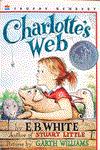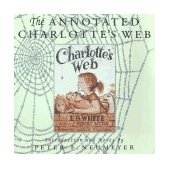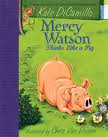Charlotte's Web

by White, E. B.. Illustrated by Garth Williams. (HarperCollins, 1999 ISBN 0060263857. Order Info.) Novel. Grades 3+.

Review

This book that's brought tears and laughter to so many generations is a book that we tend to take for granted. It got no Newbery Award to put it along side the giants of children's literature: the award for 1953 went to a book called Secret of the Andes. Charlotte's Web was an also ran. The good news is that Charlotte's Web became a classic anyway.
I will admit that the book sat unread on my bookshelf for many weeks when it first came to my attention. I was teaching second grade and had two young daughters at home at the time. An aunt had given me a copy with warm recommendations. However, the cover put me off. A vulnerable little girl holds a pig. You can barely see the spider dangling over the head of a sheep. I confess that I dread reading most animal books. I know, when I see a child clutching an appealing animal on the cover of a novel for young people, that the author is going to make me love that animal and then it's going to die or be mistreated or at least be in dreadful danger. I was sure that pig was going to be killed, and so I kept opting for another book for reading aloud. Finally, I started the book, hanging on even when Wilbur's life is threatened in the first line. Of course I went on. Of course I read it to my own children and to the children at school and to many, many children since then. What a perfect book it is!
Look how Charlotte's Web has affected us. Spiders all over America probably don't realize how often their lives have been spared because the person who spies one in the house has read Charlotte's Web. No such reader has ever looked at a young pig without thinking of Wilbur. Surely we've looked at spider webs hoping to spot some trace of a word in its intricacies. And, while most of us still fail to appreciate rats, we do smile at the gluttonous but ultimately heroic Templeton. I defy anyone to read the book without shedding tears over Charlotte's death, the account of which ends with one of the saddest lines in literature "No one was with her when she died."
If there's another book in the field that has handled the inevitability of the cycle of life with more skill and wisdom, I don't know it. At the same time White pokes gentle fun at advertising and human nature while he celebrates the simplicities of farm life.
One more beauty of the work is that it can be understood on so many levels. Children much younger than eight may be too young to deal with the death of a favorite character, but kids from that age up can usually handle it. It takes some maturity and acuity to see through the action to deeper meanings and it is unfortunate if children, having heard the book in the early grades, are not encouraged to approach it again in fifth or sixth grade. Adults, of course, can get even more meaning.
As for activities for the classroom before, during and after reading Charlotte's Web, be very, very careful. Any work of literature for children can sink if it is overworked or trivialized with barely relevant skills work, and a thing of intricate beauty like Charlotte's Web is particularly vulnerable. Any of the suggested activities below should be approached with caution and never continued until destruction of the literature or interest sets in.

Activities
- Some research on spiders usually comes about naturally as the book is shared. Grab some nonfiction material and leave it where kids can get at it. Search the web for some of the best spider resources for kids. Post and share whatever information children come upon.
- The characters in the book can take a bit of discussion. Children can make silhouettes of them and on those creations put words to describe them. Model the activity with a silhouette of Wilbur and ask the class for some words to describe him. Place those words on the silhouette but then ask the children to find evidence in the story to support each one. Attach those explanations to the words. Their own silhouettes should bear similar words and defenses.
- Like many works of literature there are multiple quests in the novel. Each of the main characters and some of the supporting cast members want something. Make a class list of all the characters in the book and assign quests to as many characters as possible. As in life, of course, some reach their goal while others change quests, get something else or fail entirely. A chart of who got what might look like this:
CHARACTER QUEST RESULT Wilbur Not to be killed He lives Charlotte To save Wilbur He lives - Of course, as the story reveals, Wilbur soon has another quest, to have Charlotte live too and, in that, he fails. Fern too changes her quest, or at least her interest. You may need to add multiple quests to the chart. This whole activity makes for a good discussion group since there are few absolutes and arguments can be made to support many ideas about quests.
- As the action in the book continues, we can follow one character and see how he or she feels about what is happening. Such feelings can be shown by making a flow chart of the main events in the book and then discussing or charting how Wilbur, Charlotte, Fern or Templeton feel at that point and why.
- As in most good stories, some characters grow and change as a result of the action. Other characters remain pretty much as they were from the beginning. Charlotte doesn't really change much in the story. She was a pretty wise creature at the beginning of the action and remains so throughout. Wilbur changes thanks to his friendship with Charlotte. Fern changes from a little girl who can understand what animals say to one who cares much more about Henry than the goings on in the barn. Again, a discussion of who changes, how much, and why can be a good one.
- Some readers will be able to get deep enough into the book to think about what the author's purpose is -- the theme, in other words. What is it that White wants us to know about a farm, about friendship, about sacrifice and about life and death? Don't expect all children to get to that level but, if ever there was a book in which such weighty matters are discussed, it's Charlotte's Web.
- We laugh at the gullibility of the public who take Charlotte's advertising campaign at face value, admiring the pig instead of the spider, and usually some child spots that phenomenon during the reading of the book. It's an easy step from there to a look at our own susceptibility to advertising campaigns. Devising a way to survey the effect of advertising on the purchases made by class members and their families can involve some careful problem solving and the results can be displayed in a variety of ways.
- In this election year it's a small step from the above activity to looking at ways various candidates are presented by their own supporters and labeled negatively by their opponents -- the words in the webs, so to speak.
- And with that, we leave you, a long way from the peaceful barn in Maine. Have fun.

Related Books
 The first book true Charlotte fans need to own besides the novel itself is Peter Neumeyer's The Annotated Charlotte's Web (HarperCollins, 1994 ISBN 0060243872. Order Info.). Here you'll find out about the eight revisions of the novel, a running commentary by Neumeyer with fascinating information, a brief biography of E. B. White and extensive footnotes. The book provides valuable insights and appreciation some of which can be passed on to children.
The first book true Charlotte fans need to own besides the novel itself is Peter Neumeyer's The Annotated Charlotte's Web (HarperCollins, 1994 ISBN 0060243872. Order Info.). Here you'll find out about the eight revisions of the novel, a running commentary by Neumeyer with fascinating information, a brief biography of E. B. White and extensive footnotes. The book provides valuable insights and appreciation some of which can be passed on to children.
 The Tiny Seed by Carle, Eric. (Little Simon, 2009 ISBN . Order Info.) Picture Book. Grades PreK-2.
The Tiny Seed by Carle, Eric. (Little Simon, 2009 ISBN . Order Info.) Picture Book. Grades PreK-2.
We follow a seed from birth to flower to seed again. It's fall and the seeds are being blown along by the wind. Obstacles abound, but one seed is able to grow to maturity where it faces more perils. This classic, first published in 1970, is a great introduction to the life-cycle of flowering plants but also a beautiful philosophical look at life. See our Featured Book Teachers Guide with a review, discussion ideas, activities, related books and links.-
 Mercy Watson Thinks Like a Pig by Kate DiCamillo. Illustrated by Chris Van Dusen. (2008, Candlewick. ISBN 9780763632656. Order Info.) Easy Reader. 70 pages. Gr K-4.
Mercy Watson Thinks Like a Pig by Kate DiCamillo. Illustrated by Chris Van Dusen. (2008, Candlewick. ISBN 9780763632656. Order Info.) Easy Reader. 70 pages. Gr K-4.
For an easy reader with a pig in the lead see fifth book about the pig, Mercy Watson, in this easy reader. The text is rich with judiciously sprinkled juicy words like "unmentionable" and "eclaires" and "gracious". In this installment Mercy's neighbors--the elderly women, named Eugenia and Baby, have decided to beautify their yard by planting pansies all around, which Mercy finds delicious. Read a Full Review.

Related Areas Within Carol Hurst's Children's Literature Web Site
- Death, Dying and Grief through Kids' Books:
Death, Dying and Grief as Classroom Subject or Theme, Grades Preschool-Ninth: An Annotated Booklist of Some of Our Favorite Children's Books, Some with Links to More Material for Teaching This Topic.  Babe the Gallant Pig. Book Review.
Babe the Gallant Pig. Book Review.
-
The Tiny Seed by Eric Carle. Featured Book Teachers Guide with review, discussion ideas, activities, related books and links.
- Farms in Children's Books. Featured Subject with activities, related books and links.
Advertisement:
Picture Books in the ClassroomMake curriculum design a snap!!Meet your state's requirements while strengthening all areas of your curriculum.Starting with the best of the best in picture books for kindergarten through second grade, Carol Hurst shows you how to use them effectively in the classroom. Each of the skills in the picture books is clearly labeled with recurring images for social studies, math, science, language arts, music, physical education and art. So the teacher can find the relevant listings with ease. This makes designing a new unit a breeze. Then Ms. Hurst takes the best authors and illustrators separately and shows their most important books for classroom use. A treasure-trove of effective materials to open young minds to new skills! And to an appreciation of the fun in reading books! Are Frog and Toad brave? Might they just think they are? What people do you know about who are considered brave? Now what evidence can you give to back up that idea? In Martin's "The Finest Horse in Town," the two children that the author imagines might have taken care of Prince got two pennies a week for their job. Figure out how much money they would have if they kept care of Prince through all the seasons the book says they did. How will you go about figuring that out? |

|
Advertisement:
Advertisement:
Advertisement:

